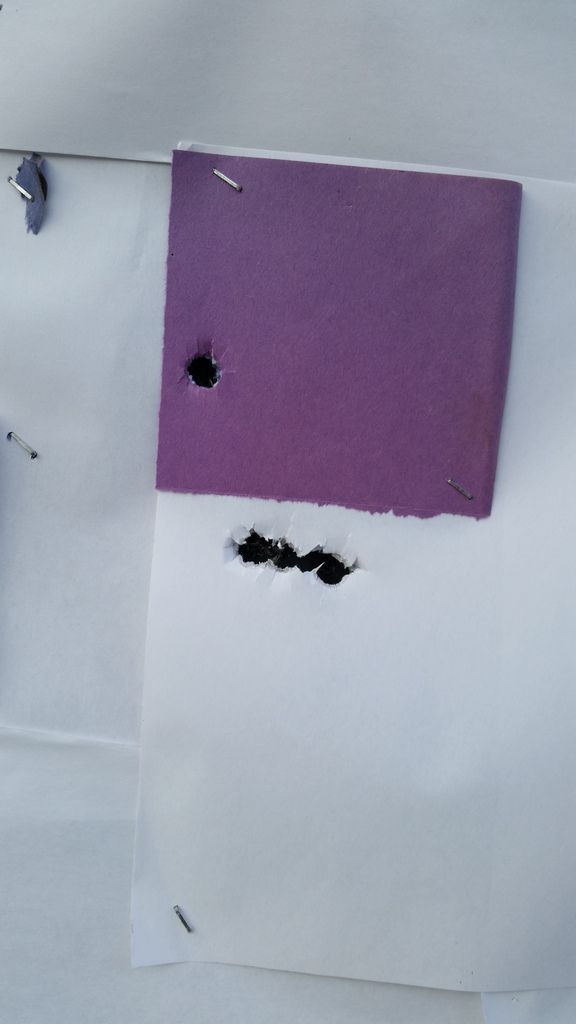Gene L said:
So I feel claims to shoot a lot better than three MOA (or so) with ML rifles especially with period rifles are grossly mis-represented. Considering that our ancestors had powder of dubious quality and erratic patching material, I think it's a myth, but considering the accuracy standards of the day, we Americans were definitely superior marksmen...just not like today's marksmen.
Minute of angle for a three shot group at 100 yards is doable from a bench with a round ball rifle larger than .32 caliber, not sure about .40 caliber, but definitely with a .45 or larger round ball rifle. It does take some work to find the correct powder charge and type of powder, ball, patch and lubricant the rifle likes.
It also takes some training and discipline to learn to shoot that well. Yes, I have seen it done at International Muzzle Loading Shooting competition with original rifles at the 100m prone and this from Ladies shooting. The groups will open up after three shots and especially when shooting 10 shots or more, but much of that is from Shooter Error rather than what the rifle is capable of doing.
Shooting competitions in the 18th century were often done with only one shot and often at around 60 yards, so we don't have much information on how well they shot groups. Spence had a quote from one of the best Hunters in Kentucky in 1820 and most likely a flintlock rifle and not a match rifle. That hunter bet people he could hit a silver dollar (around 2 1/2" diameter then as now) and the winner would get a dollar each time he did it. The person did not bet, but others said the hunter was able to do it on almost every shot. The quote did not say if the Hunter used a rest and he may well have or even probably did so or shot from prone.
I grew up hunting mainly with a shotgun, though some .22 rifle shooting and .22 pistol for raccoon hunting. Because .22 ammo was cheap, I got quite good at hitting upright soda pop bottles offhand at 25 yards and breaking them into three pieces with follow up shots; hitting the tops first, then in the middle, then at the bottoms. However, I never fired a large caliber rifle until I entered Marine Boot Camp six days after my 18th birthday.
In Boot Camp, we had what was called "Snapping In Week" that was some of the most intensive and body aching work at getting into the tightest positions possible, so we would shoot our best the next week for initial qualification with the rifle. I was in fairly good shape before I went to Boot Camp, but that training cause a lot of body ache each night. However, it allowed us to shoot really well the next week.
Six days before I graduated Boot Camp and came home on Boot Camp leave, I came down with walking pneumonia. Yet, I recovered well enough to come home on time to Iowa in January. I purchased a TC .50 caliber "Hawken" Rifle and the accessory kit. Grandpa helped me cast balls from the mold in the kit and I used the patch and lube in the kit. I bought Dupont powder. I just HAD to shoot that rifle before I went back from leave as I had dreamed of owning a muzzle loader for years.
We did not belong to the only range anywhere in the county, so we went to a public recreational area when it was 10 degrees above Zero with intermittent icy winds. We measured 100 yards using a tape measure and set up a paper target. I brushed snow off the frozen ground and sat down to take up the best sitting position possible. I thought about trying prone, but just could not get myself to actually lay down on that frozen ground. Grandpa was the last person in our family to have fired a muzzle loader, but he had done it as a boy. So Dad and I had never done it.
I used the suggested charge of 60 grains of black powder. Young eyes, superior marksmanship training and the natural accuracy of that rifle allowed me to shoot a three shot group where the furthest distance between two shots was between 1 5/8 and 1 3/4 inch. I could not measure more accurately as it was so cold and my hands were shaking after I had loaded and fired three times. In better weather and once I found the most accurate load for that rifle, it was capable of shooting three round 1 1/2 inch groups at 100 yards all day long
from the bench. Of course I could not hold that tight of group offhand, but from sitting and especially prone, it was quite common.
Now, I was never good enough to shoot on any of the Rifle Teams in the Marine Corps, because of the astigmatism in my eyes. I was also never good enough to get into the top five of any of the primitive matches I shot at Spring and Fall shoots at Friendship, IN in the last half of the 1970's.
Still that TC Hawken Rifle would shoot BETTER than I was capable of shooting at 100 yards and I was able to shoot 1 1/2 inch three round groups with it.
Gus






















